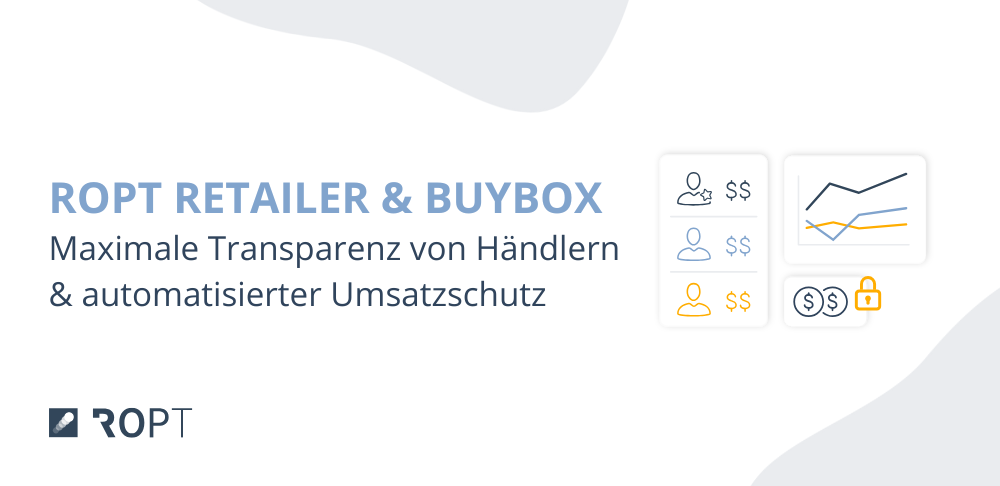Be honest – how often do you expand your PPC-keywords? And how often do you check their indexing? The disciplines of keyword research and keyword relevance are often rudimentarily depicted and underestimated by distributors. In this article, we demonstrate how you can optimize your Amazon PPC keyword-set and why these disciplines should be integrated as processes into your Amazon marketing and not as one-time components.
Fortunately, more and more merchants are well aware that a bid manager is indispensable for long-term success in the field of Amazon advertising. Many merchants regularly invest resources in monitoring, analysing and optimizing their superordinate KPIs, but, unfortunately, without taking sufficient account of one of the most important basic indicator – the keyword-set.
The keyword-set is the foundation for your success, which can significantly influence sales and profitability – both in the field of Amazon PPC advertising as well as organically. A broad understanding of the target audience, the competition, the marketplace, the trends, and of other time-related factors is the groundwork for extended and profound keyword researches and, consequently, valuable keyword-sets.
Merely copying keyword lists from the usual keyword tools just doesn’t do it.
Defining Amazon PPC goals
Every keyword research is different. Why? Because goals, resources (budget, time, data), homogeneity of the product range and brand awareness can differ substantially. Thus, the keyword strategy is always customized, type and extent of the keyword-sets determined significantly.
First outline your goals and options in order to make the subsequent research more efficient. The time factor for successful research processes should not be underestimated. For small product portfolios, it pays to work out the maximum, for dynamic portfolios with hundreds or thousands of products compromises have to be made.
Keyword researches for Amazon PPC
On ASIN level, the keyword set should be individual (depending on product features, target audience, pricing and brand awareness) and dynamic (depending on season, trends, internal and external competition and PPC knowledge) and fully indexed for the Amazon search. For simplicity’s sake, we now assume that we would like to research all possibly relevant keywords for our product. Please consider that the process of keyword research and keyword selection is always individual due to your goals, strategies and resources.
Now we try to precisely cover all possible search phrases of a potential customer. Example: If „toaster 2 slices wide slot“ is supposedly searched for, we store exactly that phrase in our Sponsored Product Ads (SPA) or Sponsored Brands, and not just „toaster“ or „toaster wide slot“. Thereby, very long keyword lists occur, which individual elements often repeat themselves, but are only updated once into the product data – more on keyword relevance later.
Attention: Keyword and search term are not identical! Amazon explains the difference as follows: „A customer search term is the exact set of words a customer enters when searching for a product on Amazon. A keyword is the word or set of words you bid on in Campaign Manager to target your ads to customers.“
Preparation
Before you start the keyword search, you should answer the following questions:
- Which properties does the product describe? (e.g. functions, colours, fit, theme, feel, size/quantity)?
- What use does the product have?
- Who is the target audience (differentiate between buyer and user)?
- In which price and quality segment is the product located?
- Is the product subject to seasonality?
In order to keep the overview and to be able to combine keywords more efficiently later, a categorization of the developed information and keywords is recommended (for example with Excel).
During research, we differentiate between keyword stem and additional keyword. We define the keyword stem as a keyword that, when viewed in isolation describes the product comprehensibly and requires as few words as possible.
Example: Correct: „spice mill“ or „salt and pepper mill“ – Wrong: „salt“ or „spice mill black“ (because „spice mill“ is already a keyword stem). Additional keywords can complementarily be placed in front of or behind the keyword stem.
Cluster Procedure
For the beginning of the research, we recommend you to not be immediately influenced by keyword tools, but to create an uncensored base. For that, the so called cluster procedure is suitable. Clustering is a brainstorming procedure in which, originating from the core of the cluster, associations are listed and logically connected. It stimulated creativity and ensures an intensive confrontation with the product, use and target audience.
Especially additional keywords can be worked out particularly well by reflecting on the questions that have already been answered. Thus, you do not get caught in the limited bubble of keyword databases. Due to the fact that our memory performance is based on association chains and the individual associations are influenced by experiences, this is a subjective point of view that possibly only covers a part of the target audience.
Inspirations for keyword stems and additional keywords
Scan
- thematically fitting platforms for categories, filters, product titles, SEO-descriptions and brand names, as for example ASOS, Wayfair, zooplus, BESTBUY, Walmart, IKEA, MENARDS (for german language Zalando, Otto , Conrad, CONTORION, Billiger.de, ALTERNATE, Media Markt, Fressnap, Hagebau, myToys, Rewe)
- the product data, reviews, seller ratings, questions, and categories of your competitors on market places such as amazon, ebay, Jet, AliExpress, etsy, Wish, real and Rakuten
- Dictionary.com, Thesaurus.com and Woxikon, to find synonyms and usual spellings
- Keywordtool.io and Google Keyword Planner, to receive first relevant keyword combinations from Amazon’s and Google’s search slot
- wikipedia.org, to familiarize with the origin, development history and distribution ofyour products – and to find further usual names of your product!
- regional differences such as idiom
- news pages and social media channels regularly
- search term reports of existing Amazon campaigns
- search term data in Brand Analytics (Seller Central / ARAP)
Now you should have found a variety of keyword stems, which need to be expanded as follows:
- Separation of jointed words, because many words are searched for incorrectly
- usual spelling mistakes and typing errors, because Amazon does not correct all
- mistakes (in long-tail area partially none at all)
- combine all keyword stems with the matching additional keywords, e.g. via Excel formula
Use Amazon search suggestions
Since Amazon does not publish any official search volume concerning keywords, Amazon search suggestions are valuable indicators of the relevance of a keyword. The displayed search suggestions are updated regularly and are always sorted by relevance, thus, decreasing search volume. The function Amazon autocomplete also enables us to expand the previously gathered keyword stems, so the various long-tail keywords can be identified. Try to create routine for checking new or changed search suggestions – it’s not done with just one search before product launch!
Using keywordtool.io, the search suggestions can be generated without manual input into the Amazon search slot. The tool simulates the search in the form [keyword] [blank space] [a-z /0-9] and saves the first ten suggestions (in the free version only five). Attention: Since only the first level after the keyword stem and only the letters a through z are simulated, various (important) keywords are missing.
Considered:
- toaster a leads to: toaster and kettle sets, toaster and kettle, toaster and kettle sets
- toaster b leads to: toaster bags, toaster bags reusable, toaster black, toaster blue,
Not considered:
toaster bl leads to: toaster black stainless steel, toaster black 4 slice, toaster black 2 slice, toaster black and decker white
You should be aware that keywordtool.io only displays a fraction of the possible search suggestions and you would need to do various manual entries for a more complete result. For a more powerful keyword suggest tool contact MOVESELL.
Keyword relevance – this is how you generate traffic
The best keyword-set it worthless, if you do not receive any ad impressions by Amazon. The following prerequisites apply for ad impressions:
- The advertised product is in the Buybox and retail ready
- The advertised keyword was indexed for Amazon advertisement.
The indexation can be achieved through the placement of the keyword in the product title, the bullet points, the product information, the backend search terms, and the product description (only under specific conditions). For the play of the PPC-ad, usually each part of a possible keyword phrase, as for example „toaster long slit 4 slices“, has to be placed and indexed. It is basically irrelevant for the indexation how often the respective word was placed in the product data.
Max out the potential of variants family – through that an extreme amount of keywords can be placed in just one product. Always take the category Style Guide into account, since a non-compliance can lead to a loss of visibleness. The product’s assigned category can strongly influence the indexation – experiments are often counterproductive – unless you neatly track all changes and perform the change of the category carefully. Check regularly if your desired keywords were actually completely indexed.
Why ads can be played for keywords that are not deposited in the product data
- Amazon still considers your product relevant (e.g. for similar brands).
- Relevance was signalled through PPC-advertisement (rarely).
- Keywords were deposited in the past.
In addition to the basic requirements, there are additional factors that are often crucial
- Relevance score of the ASIN by Amazon for a specific keyword
- Keyword bid
- Campaign budget
Do you receive, despite Buybox and retail readiness, exorbitant high bid, adequate campaign budget, correct category, appealing product picture and product title, no impressions for an indexed keyword, the ASIN for this keyword is currently not relevant enough. This valuable feedback should not be overrated, but reflected, for example by optimizing the keyword focus also in the onpage product data to possibly advertise new keywords or to put more emphasize on other keywords.
Amazon PPC and Amazon SEO are very much interlocked, because the basic relevance can only be managed through the onpage product data. Due to Amazon’s byte limitation, not all researched keywords can be placed at once. Regularly expand, rate, and optimize your onpage keyword-set, based on gathered knowledge, let it be through altered search suggestions or PPC-Data, to shape your PPC-campaigns on Amazon more efficient and profitable.
Keine Amazon News verpassen – mit dem kostenlosen Newsletter!

Moritz Meyer
Fragen, Feedback oder auf der Suche nach einem starken Partner?
kontakt@movesell.de / +49 431 128 2222 9
Schon gewusst? Wir sind eine führende Amazon-Beratung für alle EU-Marktplätze, Entwickler des Analyse-Tools ROPT und exklusiver Amazon Ads Agency Partner.

Henry Krause






